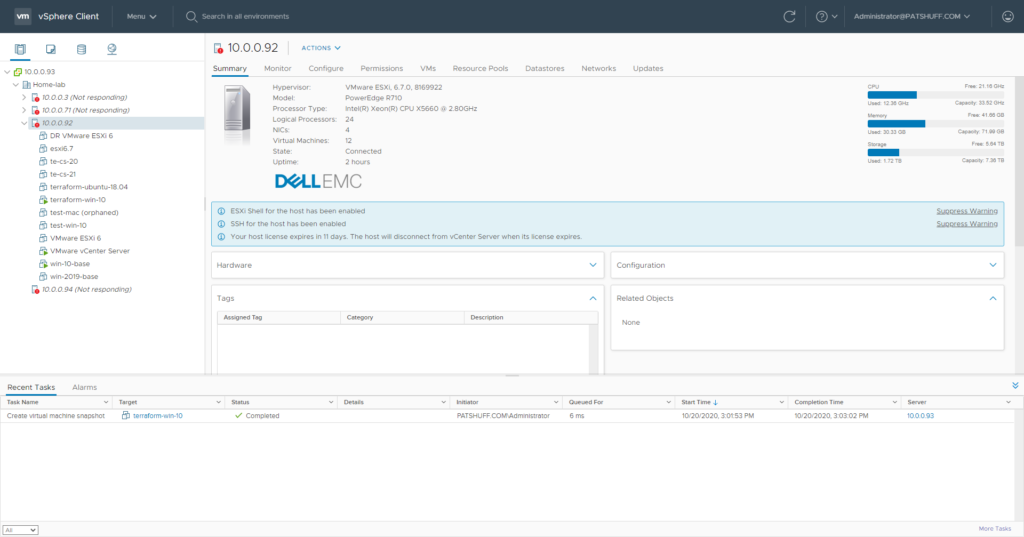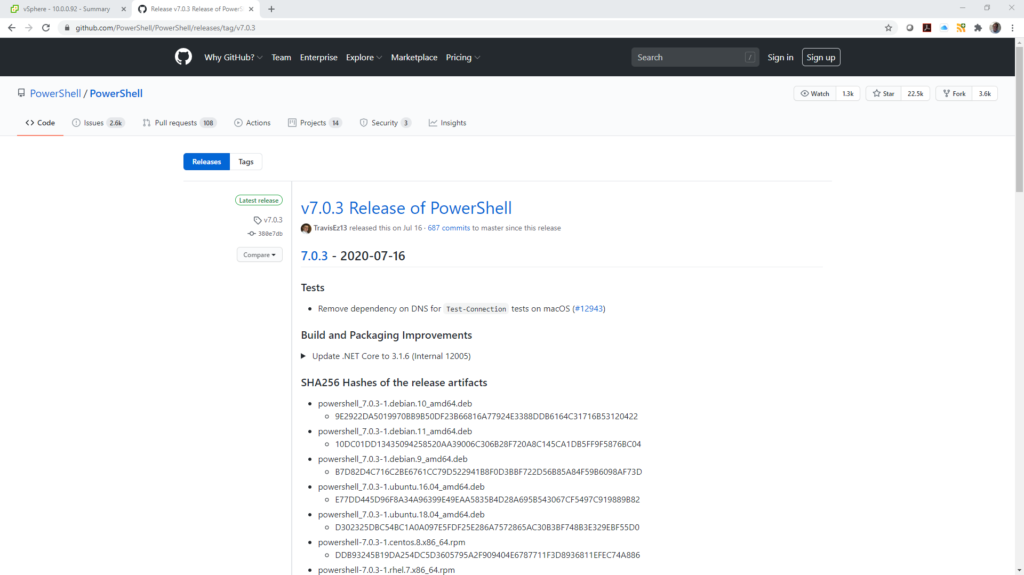In a previous blog we looked at how to identify an existing vSphere virtual machine and add it as a data element so that it can be referenced. In this blog we will dive a little deeper and look at how to define a similar instance as a template then use that template to create a new virtual machine using the resource command.
It is important to note that we are talking about three different constructs within Terraform in the previous paragraph.
- data declaration – defining an existing resource to reference it as an element. This element is considered to be static and can not be modified or destroyed but it does not exist, terraform will complain that the declaration failed since the element does not exist. More specifically, data vsphere_virtual_machine is the type for existing vms.
- template declaration – this is more of a vSphere and not necessarily a Terraform definition. This defines how vSphere copies or replicates an existing instance to create a new one as a clone and not necessarily from scratch
- resource declaration – defining a resource that you want to manage. You can create, modify, and destroy the resource as needed or desired with the proper commands. More specifically, resource vsphere_virtual_machine is the type for new or managed vms.
We earlier looked at how to generate the basic requirements to connect to a vSphere server and how to pull in the $TF_VAR_<variable> label to connect. With this we were able to define the vspher_server, vsphere_user, and vspher_password variable types using a script. If we use the PowerCLI module we can actually connect using this script using the format
Connect-VIServer -Server $TF_VAR_vsphere_server -User $TF_VAR_vsphere_user -Password $TF_VAR_vsphere_password
This is possible because if the values do not exist then they are assigned in the script file. From this we can fill in the following data
- vsphere_datacenter from Get-Datacenter
- vsphere_virtual_machine (templates) from Get-Template
- vsphere_host from Get-Datacenter | Get-VMHost
- vsphere_datastore from Get-Datastore
The vsphere_datacenter assignment is relatively simple
$connect = Connect-VIServer -Server $TF_VAR_vsphere_server -User $TF_VAR_vsphere_user -Password $TF_VAR_vsphere_password
$dc = Get-Datacenter
Write-Host ‘# vsphere_datacenter definition’
Write-Host ‘ ‘
Write-Host -Separator “” ‘data “vsphere_datacenter” “dc” {
name = “‘$dc.Name'”‘
‘}’
Write-Host ‘ ‘
This results in an output that looks like…
# vsphere_datacenter definition
data “vsphere_datacenter” “dc” {
name = “Home-lab”
}
This is the format that we want for our parameter.tf file. We can do something similar for the vm templates
Write-Host ‘# vsphere_virtual_machine (template) definition’
Write-Host ‘ ‘
$Template_Name = @()
$Template_Name = Get-Template
foreach ($item in $Template_Name) {
Write-Host -Separator “” ‘data “vsphere_virtual_machine” “‘$item'”‘ ‘ {
name = “‘$item'”‘
‘ datacenter_id = data.vsphere_datacenter.dc.id
}’
Write-Host ‘ ‘
}
Write-Host ‘ ‘
This results in the following output…
#vsphere_virtual_machine (template) definition
data “vsphere_virtual_machine” “win_10_template” {
name = “win_10_template”
datacenter_id = data.vsphere_datacenter.dc.id
}
data “vsphere_virtual_machine” “win-2019-template” {
name = “win-2019-template”
datacenter_id = data.vsphere_datacenter.dc.id
}
We can do similar actions for vsphere_host using
$Host_name = @()
$Host_name = Get-Datacenter | Get-VMHost
as well as vsphere_datastore using
$Datastore_name = @()
$Datastore_name = Get-Datastore
The resulting output is a terraform ready parameter file that represents the current state of our environment. The datacenter, host, and datastores should not change from run to run. We might define new templates so these might be added or removed but this script should be good for generating the basis of our existing infrastructure and give us the foundation to build a new vsphere_virtual_machine.
To create a vsphere_virtual_machine we need the following elements
- name
- resource_pool_id
- disk
- label
- network_interface
- network_id
These are the minimum requirements required by the documentation and will allows you to pass the terraform init but the apply will fail. Additional values that are needed
- host_system_id – host to run the virtual machine on
- guest_id – identifier for operating system type (windows, linux, etc)
- disk.size – size of disk
- clone.template_uuid – id of template to clone to create the instance.
The main.tf file that works to create our instance looks like
data “vsphere_virtual_machine” “test_minimal” {
name = “esxi6.7”
datacenter_id = data.vsphere_datacenter.dc.id
}
resource “vsphere_virtual_machine” “vm” {
name = “terraform-test”
resource_pool_id = data.vsphere_resource_pool.Resources-10_0_0_92.id
host_system_id = data.vsphere_host.Host-10_0_0_92.id
guest_id = “windows9_64Guest”
network_interface {
network_id = data.vsphere_network.VMNetwork.id
}
disk {
label = “Disk0”
size = 40
}
clone {
template_uuid = data.vsphere_virtual_machine.win_10_template.id
}
}
The Resources-10_0_0_92, Host-10_0_0_92, and win_10_template were all generated by our script and we pulled them from the variables.tf file after it was generated. The first vm “test_minimal” shows how to identify an existing virtual_machine. The second “vm” shows how to create a new virtual machine from a template.
The files of interest in the git repository are
- connect.ps1 – script to generate variables.tf file
- main.tf – terraform file to show example of how to declare virtual_machine using data and resource (aka create new from template)
- variables.tf – file generated from connect.ps1 script after pointing to my lab servers
All of these files are located on https://github.com/patshuff/terraform-learning. In summary, we can generate our variables.tf file by executing a connext.ps1 script. This script generates the variables.tf file (test.yy initially but you can change that) and you can pull the server, resource_pool, templates, and datastore information from this config file. It typically only needs to be run once or when you create a new template if you want it automatically created. For my simple test system it took about 10 minutes to create the virtual machine and assign it a new IP address to show terraform that the clone worked. We could release earlier but we won’t get the IP address of the new virtual instance.





